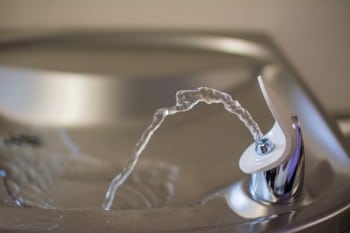By: Joanne Benz
Lead is a toxic metal, and exposure even in low levels can harm children’s health, possibly damaging the brain and nervous system, according to the Federal Centers for Disease Control and Prevention. While the water flowing into the schools is safe, lead can leach into it from pipes, fixtures or solder in the plumbing. The threshold of how many parts per billion that is acceptable seems to vary state to state. However, 1 part per billion is the threshold recommended by the American Academy of Pediatrics, according to Deirdre Cummings of the Mass PIRG Education Fund. The academy “basically said that there is no safe level,” of lead, Cummings added, but that level is meant to indicate that “anything above 1 part per billion is dangerous and we need to eliminate it.”
BACKGROUND
For centuries, workers used lead for plumbing because the metal was malleable enough to mold into pipes, yet hard enough to resist corroding and leaking over time. Once scientists and environmental experts discovered that lead leached from pipes transporting water, Congress banned the use of lead pipes in a 1986 amendment to the Safe Drinking Water Act.
STATES THAT MADE HEADLINES
Pennsylvania, New York, Maine, Ohio, Michigan, Maryland, New Jersey, Wisconsin, Illiniois, Oregon, Georgia, California, Texas, Washington D.C.
Very few states require schools to check for lead [I could only find seven when I wrote this: California, Illinois, Maryland, Minnesota, New Jersey, New York and Virginia]. And, the federal government doesn’t require it either. Thousands of schools scrambled to test after learning that lead had seeped into the public water supply and created a public health crisis in Flint, Michigan, but lead experts say that the majority of schools across the country still don’t know what’s in their water.
California Assembly Bill 746 published October 2017, effective January 1, 2018, requires community water systems to test lead levels by July 1, 2019 in all drinking water at all California public, K-12 school sites that were constructed before January 2, 2010.
Arizona acted in January 2017, the Arizona Department of Environmental Quality provided schools with free tool kits that include instructions, collection containers and prepaid shipping boxes to mail to local laboratories. “What we wanted to do was help schools and screen their water for them rather than putting the burden on them where they would have to pay for the costs,” ADEQ director Misael Cabrera said. Cabrera said 96 percent of the schools have passed the screening. Arizona doesn’t require schools to replace pipes if they test positive for lead. It doesn’t yet have a program to help schools financially if they do find lead, but a DEQ spokeswoman said the School Facilities Board is working with districts to provide grant funding for schools in need.
How to Test
Here is link to the U.S. Department of Health on how to test the water in drinking fountains. https://www.doh.wa.gov/Portals/1/Documents/Pubs/331-261.pdf
SAFEGUARD YOUR WATER WITH A HAWS FILTER FOR DRINKING FOUNTAINS
Model 6426 is a lead removal 10″ x 2″ (25.4 x 5.1 cm) in-line filter with 1/4″ NPTF inlet and outlet. Reduces lead from incoming water to levels below 15 ppb (@ flow rate = 0.5 gpm (1.3 L); pressure = 60 psi (4.2 bar)) for up to 500 gallons (1893 L). Filters particulate lead to 10 microns and absorbs soluble lead. Does not leach lead once absorbed. Performance demonstrated under NSF Standard 53 and 42 by independent, certified testing laboratory.
Haws manufactures drinking fountains and electric water coolers to be lead-free by all known definitions including NSF/ANSI Standard 61, Section 9, California Proposition 65 and the Federal Safe Drinking Water Act.




